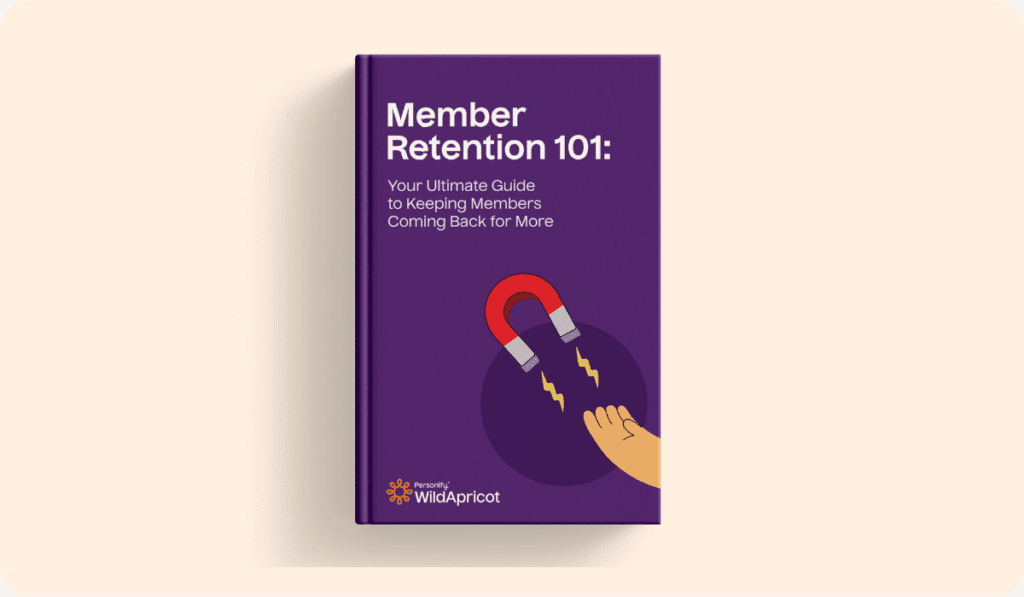First impressions are important. While a prospective member may have visited your membership website or attended an event before deciding to join, filling out a membership application is when they make it official.
Think of membership application forms as the first step in the getting-to-know-you process. Not only are prospective members sharing their personal information, but they’re also being officially introduced to your organization. You’re rolling out the welcome mat!
When you think about it, this form says a lot about your organization. An attractive, easy-to-find and easy-to-use application form shows that you’re thoughtful, welcoming and understand the needs of your members. On the other hand, a complicated and time-consuming form isn’t going to build much confidence.
Here are a few ideas for fine-tuning your existing or building a new membership application form!
Or, if you just want to skip to our examples and template, click here.
1. Is Your Membership Form Easy to Find and Complete?
Membership application forms should always be easy to find on your website.
Whether you have a “Join Us” or “Join Now” button, a membership page or a menu tab, be sure the membership form isn’t buried deep in your website’s navigation.
Here’s an example of an easily accessible membership form:

What else will they need to know?
For a smooth application process, be sure all of the information needed to complete the form is close at hand. This could include:
- Necessary credentials
- Membership levels and their perks
- Fees for each level
Some organizations offer links to information right on their membership forms (see below!). Others have a “Membership” page on their website that includes a direct link to the form.

Whatever you do, reduce the number of necessary clicks. If a prospective member has to go look for information elsewhere, they might get frustrated and give up before completing their application.
Is it easy to complete?
You don’t want a prospective member struggling to fill in your form, so keep the application simple and easy to complete.
For example, if you require applicants to read through a full page of instructions, a guide or an FAQ, it’s a sign that it’s a bit too complicated.

Be sure to offer clear instructions on either your printable form or on the screen for online forms. Just by looking at your form, they should understand exactly what it is they need to fill out!
And as we said above—make sure you have easily accessible links that answer any questions they might have about things like fees!
Does your membership application close the sale?
Membership forms and pages are the final push in convincing prospective members to join! That’s why it’s important to ensure that key information (like member benefits and networking opportunities) is close at hand.
Some organizations even go one step farther and offer testimonials on their membership page. This puts a human face on the organization and its membership—plus, recommendations from other members can be extra persuasive.
Here’s an example of a testimonial from the Senior Dining Association:
Of course, if you decide to include recommendations or testimonials you’ll need to get permission to use them. Be sure to include the full name, title and organization, along with a photo if you can (or even a video like the example above).
2. What Information Should Be Included on Membership Application Forms?
The key goal of your membership application form is to capture transactional information. This includes your members’ contact information, as well as fee payment.
But membership forms are also an opportunity to know your new prospective member and motivate their participation in your organization. The challenge is finding a balance between gathering the information you need and providing additional details without making the form feel daunting.
“Need to have” items:
Here are some of the key items your member application form should include:
-
Membership types (e.g., levels and their fees)
-
Membership requirements (e.g., if candidates require specific designation, education, credentials, a professional conduct statement, etc.)
-
Membership/subscription term (e.g., renews annually)
-
Contact information (e.g., name, organization, address, telephone, email, etc.)
-
Pertinent personal information required (e.g., date of birth, etc.)
-
Conditions of membership (e.g., terms, privileges, responsibilities involved, etc.)
-
Payment options and process details (e.g., online payment, check, etc.)
-
Details on application process (e.g., if the application needs to be reviewed by a committee, etc.)
-
Previous membership (e.g., if they are a former member)
-
References or sponsors (if required)
-
Chapter/Affiliate/Region information (e.g., if it is a multi-chapter organization and membership is assigned based on particular criteria)
“Nice to have” items:
The following may be included on the form or offered as links to pages on your website. You may want to distinguish between the information fields that are mandatory and those which are “nice to have” such as:
-
Membership benefits and/or your “promise” of what membership in your organization will offer.
-
Personal or professional interests / type of information they want to receive (e.g., government relations, advocacy, legal, professional development, etc.).
-
Committees/Task Forces/Volunteer positions / what opportunities are available for your members to participate in.
-
Privacy/sharing: You may want to indicate what information will be shared (e.g., on membership directories or elsewhere on your website); what will be available to volunteers, such as board members; and what information will only be available to staff administrators.
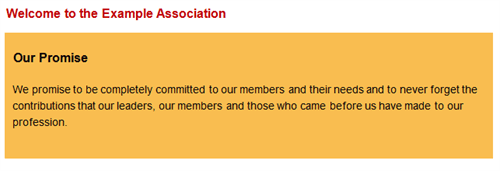
3. Can the Look and Feel Make an Impact?
If it’s been a while since you looked at your membership form, take a good fresh look right now. What’s your immediate impression? Is it attractive and easy to use?
Researchers found that it only takes one-tenth of a second for visitors to a website to decide the attractiveness of a web page. This means your prospective member will make up their mind about registering within a few seconds of clicking on your page!
If the form looks complicated, time-consuming or confusing, they may postpone completion or even worse, they might reconsider their application. Capture and keep their attention with a welcoming page and simple process.
Here are a few tips for making your application form (online or off) more appealing:
Divide your form into sections
A long, unending page of text can look daunting, so it’s important to break the application form into sections.
You can break up your page by:
- Using bold headings to separate grouped fields
- Create a multistep process where each section is on a new page
- Using color or big, bold colorful headings to draw the reader from one section to another
No matter how you structure it, be sure to group relevant information together! Membership forms should always come with a sense of internal logic.
Show off your organization’s personality
If you’re a community organization or networking is your strength, you want a design that’s nice and friendly. On the other hand, if you’re working with professionals and corporate members, you might want something more formal.
Speak to your audience by strategically using:
- Branded typeface, color and graphics
- Appealing background colors
- Your logo
- Graphic treatments to show off optional sign-up items or info (e.g., volunteer positions)
Before you post your membership application form, run it by the board of directors and see what vibe they’re getting off it!
Make it user-friendly
Completing forms is never a fun thing to do, so make yours user-friendly. Save time and energy by offering:
- Checkboxes
- Drop-down menus
- Pre-filled answers by offering checkboxes
Use a concise, but friendly tone of voice
Like color and graphic style, the tone of your application form should be in line with your audience and the nature of your organization. Whether you choose a casual, light-hearted tone or a more formal voice, be sure your questions are positive!
Avoid application forms with details about what an applicant “must not have done” and other “registration standards.” Yeesh! While it’s important to include membership criteria, keep the voice from getting intimidating.
Read More: 25 Solid Membership Website Examples & How to Create Your Own
4. What Format – Online, Offline or Both?
Completing a membership application can be a time-consuming chore, so you should offer options that make the process as quick and easy as possible.
For some people (especially younger generations!), paper forms can be a cumbersome turn-off. But less computer-savvy members will feel much more comfortable returning their applications by mail.
You know your membership audience best—what would they prefer?
Be sure to indicate the options that are available, such as:
- Joining online
- Downloading a printable application form
- Securely paying membership fees online
- Paying membership fees by cheque or phone
Why You Should Move to Online Member Application Forms
Moving to online member application forms hosted on your membership site is one of the most convenient things you can do for your donors. It also offers major benefits for the staff or volunteers managing membership administration.
Some of the benefits of using online membership forms include:
-
Increased efficiency. Online applications collect your members’ personal and financial information immediately and automatically. It saves your staff time on things like transferring print information into the database or waiting on credit card approvals.
-
Accurate and protected data. Since information is seamlessly stored in your member database, it ensures that contact information is correctly recorded. Plus, any future updates can be made by the member through online member self-service. Automatic data back-up also puts everything “in the cloud,” so there is no chance of losing precious member information.
-
Anytime, anywhere access. As long as they have access to WiFi, members can sign up immediately and impulsively from any device. No downloading forms or mailing anything in to slow them down! Better yet, anyone with administrative permission to your online membership management system can easily access this information from the moment the application is completed.
-
Secure online payments. With an SSL certified website, you can assure your members that their payments can be made quickly and safely. This cuts out worries about checks getting lost in the mail while also saving time!
-
Instant confirmation and welcome: An immediate warm hello shows your members that you’re happy to have them on board. With instant access, they can go from prospective to active members without any delay.
-
It’s paperless. It’s an environmentally friendly option—save some trees as you grow your membership!
5. It’s Not Just The Form — It’s The Follow-Up Too
Once the applicant sends off their application either online or by mail, they want their membership experience to begin.
That experience begins with their confirmation email or letter. So be sure to confirm the membership and welcome them aboard as soon as you can!
Most membership management systems offer automated email welcome and confirmations that you can customize to meet your needs. If you are also accepting mail-in applications, have systems in place to follow-up on these immediately as well.
Use both your form and your confirmation email to show off the highlights of your organization, including the benefits of being a member. A warm welcome will help you start building member engagement and trust from the start.
Membership Application Form Examples & Template
Now that you’re ready to get to work, here are a couple templates to get you started:
Online Membership Form for Nonprofits Template
And here’s a template membership form for nonprofits, complete with tier level options. It can be printed or sent over in its original Google Doc format for any new members to complete.

If you’d like to edit the form above, just follow this link, duplicate the file and you’re good to go!
However, we recommend setting up online member registration forms instead, like the examples below. This kind of membership form makes it a lot easier for new members to apply to join your organization. Since it’s hosted on your website, they can easily access and submit it on their own time.
General Membership Application Form Template
This template is applicable to any organization. It’s generic, but it gets the job done!
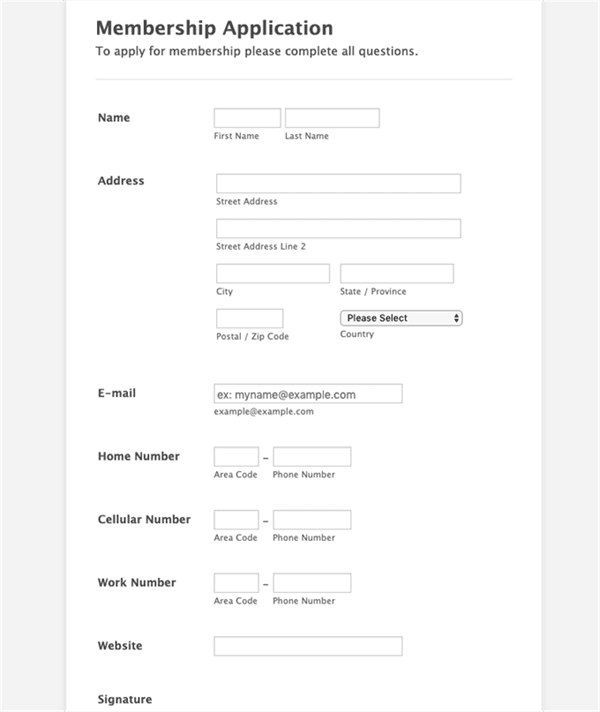
Online Membership Form for Clubs
Here is an example of an online membership form specifically made for clubs:
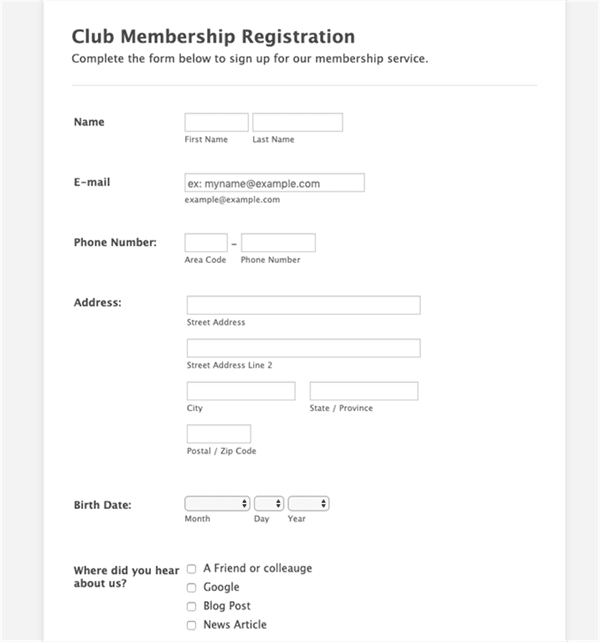
Example Membership Application Forms
If you want a more tailored version of a membership application form, check out the examples below from some of the best-known membership organizations.
This example from Toastmasters International is great for organizations who have a lot of international members, since it provides options for preferred language.

The following application comes from a social membership club and includes a section for referrals by another member:
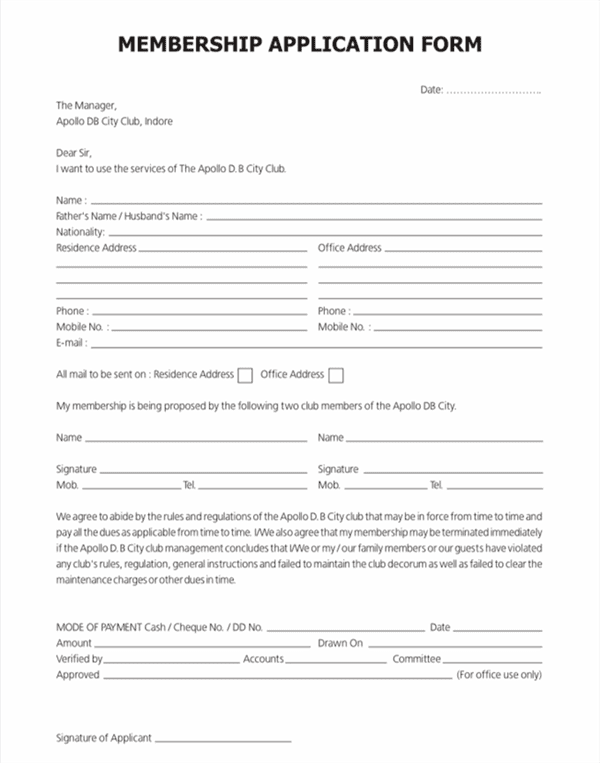
This membership form example from the YMCA includes a space to fill out family information—perfect if your organization offers family memberships or group memberships!
It also includes a section asking how the prospective member found out about your organization. This is a great way to help you track which recruitment tactics are most effective.

Quick Review – Membership Application Form Checklist
Membership application forms are the first step in building a relationship with your new member. Since first impressions really do count, it’s important that your form captures the right information while still being informative and welcoming.
Here is a checklist of questions to ask and tips to consider if you are developing or refreshing your membership form.
You can also get a downloadable version of this form here so that you can save it on your computer or share it with your team!
General Tips
- Roll out the welcome mat. Consider including a note at the beginning of your form to welcome the new member. For example, “Thank you for your interest in becoming a member of…” or “Welcome to…”
- Use a friendly tone and positive questions.
- Specify which questions are mandatory/required and which are optional.
- Indicate which information will be shared with other members (for example, in a membership directory), or available just to staff administrators.
Must-Have Information
- Membership type or level
- Membership requirements (e.g., specific designations, education, credentials, professional conduct statement)
- Membership/subscription term
- Contact information (e.g., name, organization, address, telephone, email)
- Pertinent personal information required (e.g., date of birth)
- Conditions of membership (e.g., terms, privileges, responsibilities involved)
- Previous membership (e.g., are they a former member?)
- References or sponsors (if required)
- Chapter / Affiliate / Region information (e.g., if it is a multi-chapter organization and membership is assigned based on particular criteria)
Before you publish! Did you…
- Clearly describe or define your membership categories?
- Include details on the application process? (e.g., if the application needs to be reviewed by a committee)
- Indicate the types of payment options available?
Encouraging Engagement
- Include a “promise” of what membership in your organization will offer; or an overview of the Membership Benefits and/or a link to membership details.
- Ask applicants to indicate personal or professional interests, or the type of information they want to receive. (e.g., government relations, advocacy, legal, professional development)
- List Committee / Task Forces / Volunteer positions—and ask if the new member might be interested in getting involved. Consider using checkboxes they can fill in!
First Impressions
The visual layout of your application form says a lot about your organization. Before your prospective members even get reading, they’ll be judging your form based on its visuals.
Is your form…
- User-friendly? Design elements such as checkboxes can save time. For online forms, consider drop-down menus and pre-filled answers.
- Divided into sections? Breaking the application form into logical sections (with bold headings or colored blocks of text!) draws the user through the form and makes it feel more manageable.
- Easy to read? Be sure that the type size is large enough to read without a magnifying glass. Use fonts that are clear and easy to read—and remember that mixing too many together will clutter your design!
- A reflection of your organization? You want a clean design style, but it should also convey your organization’s brand. You can use specific colors, graphics, or simply your logo and tagline or mission statement.
We hope you found these steps helpful! If so, don’t forget to download this checklist so you can access it again later.
The Best Software for Managing Your Members
One of the biggest complaints from membership managers is how much time it takes to process new member and event registrations. If you’re feeling the frustration, it’s time to look into membership management software!
Membership management software software is an all-in-one tool that completely automates the registration process online. The right software can even save some organizations up to 20 hours a week in administrative work.
Here are a few of our favorite options:
WildApricot
Trusted by 26,000+ organizations, WildApricot is the #1 choice for membership management software for small to mid-sized nonprofits.
As you gather new members for your organization with your membership form, WildApricot can provide you with:
- An online member database
- Automated membership renewals
- A highly customizable website (with members-only pages!)
- Easy, secure online payment processing
- Online event registration and store
- Email and texting support
- And much more!
With WildApricot, you can build your member relationships with comfort and confidence. If your nonprofit is just starting out, you can rest assured that our easy-to-use software comes with expert support.
Pricing for WildApricot starts at $63/month. If you’re looking to test it out, sign up for a 60-day free trial today!

“As our club grew from the 60’s to in excess of 150 members and the need to collect dues and establish membership categories arose, it became very hard to manage everything with the paper system we had been using. WildApricot solved all that perfectly.”
– Fred Finney, Vistoso Cyclists
MemberClicks
If you’re running an association, chamber of commerce or mid-sized to larger nonprofit organization, MemberClicks is a great choice!
This cloud-based membership management software has features like:
- An online membership database
- Event registration and scheduling systems
- Targeted email campaigns
- Automated dues renewals
- A website builder with integration tools
- Reports and analytics
Pricing depends on the size and needs of your organization. Reach out to get a quote from MemberClicks today!
ClubExpress

ClubExpress offers a comprehensive software for managing members of all types of clubs. Whether it’s for a hobby club or a group of like-minded individuals, ClubExpress charges based on the number of your active members.
Some of its key features include:
- Communication and marketing tools
- Membership database
- Website builder
- Payment processing
- Event calendars
- Mobile app
Pricing for ClubExpress starts at $30/month, and increases based on the number of members you have.
Doubleknot

Doubleknot is a membership management software that’s made for cultural organizations and nonprofits. This includes places like zoos, scout councils or children’s museums, so it comes with some very unique features.
These include:
- Admissions and visitor services
- POS and mobile sales
- Customer relationship management
- Fundraising
Reach out to Doubleknot to schedule a demo of their software and learn more about pricing.
360Alumni

360Alumni is made for educational and nonprofit organizations that want to manage their alumni databases.
Their alumni-specific features include:
- Event management
- Fundraising
- Job boards
- Email Marketing
Pricing is based on your membership size and includes a one-time setup fee that ranges. Demo available upon request.
Making Superb Membership Application Forms
And there you have it—all the tips and tricks for making the best membership application form you can! With your form all set, you’ll be building your relationships with members as fast as you’re bringing them in.
We hope this guide has given you the insight needed to grow your organization and engage more members in years to come.






![The Ultimate Guide to Membership Management Software For Nonprofits [2025 Edition]](https://b2993016.smushcdn.com/2993016/wp-content/uploads/2024/02/Main-Blog-Thumbnails-2025-11-06T180717.949-1024x717.png?lossy=1&strip=1&webp=1)





